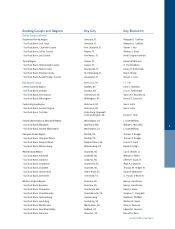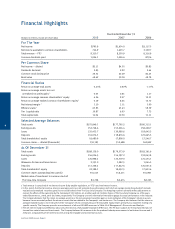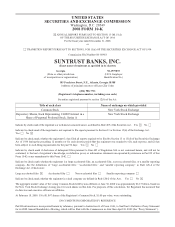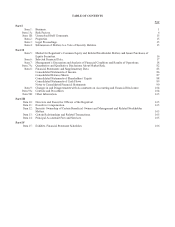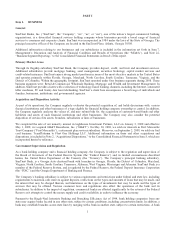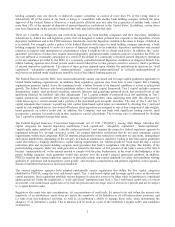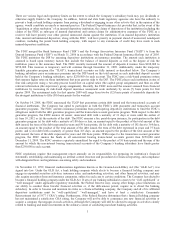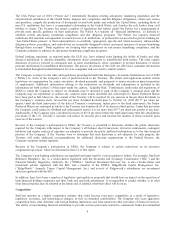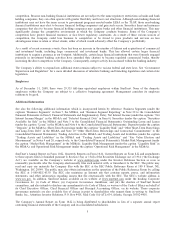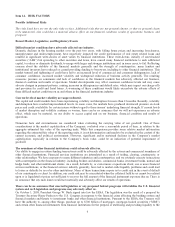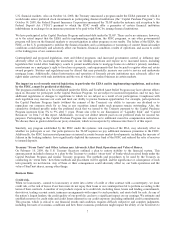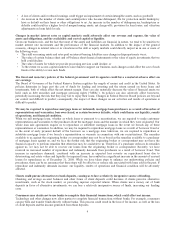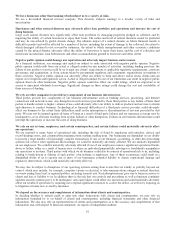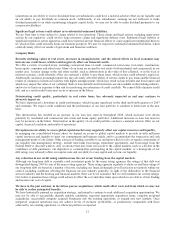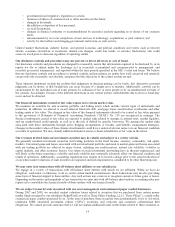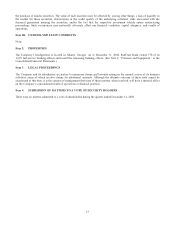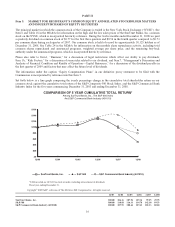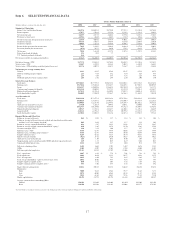SunTrust 2008 Annual Report Download - page 19
Download and view the complete annual report
Please find page 19 of the 2008 SunTrust annual report below. You can navigate through the pages in the report by either clicking on the pages listed below, or by using the keyword search tool below to find specific information within the annual report.U.S. financial markets. Also on October 14, 2008, the Treasury announced a program under the EESA pursuant to which it
would make senior preferred stock investments in participating financial institutions (the “Capital Purchase Program”). On
October 14, 2008, the Federal Deposit Insurance Corporation announced the TLGP under the systemic risk exception to the
Federal Deposit Act (“FDA”) pursuant to which the FDIC would offer a guarantee of certain financial institution
indebtedness in exchange for an insurance premium to be paid to the FDIC by issuing financial institutions.
We have participated in the Capital Purchase Program and issued debt under the TLGP. There can be no assurance, however,
as to the actual impact that the EESA and its implementing regulations, the FDIC programs, or any other governmental
program will have on the financial markets or our participation in either program on our results. The failure of the EESA, the
FDIC, or the U.S. government to stabilize the financial markets and a continuation or worsening of current financial market
conditions could materially and adversely affect our business, financial condition, results of operations, and access to credit
or the trading price of our common stock.
Contemplated and proposed legislation, state and federal programs, and increased government control or influence may
adversely affect us by increasing the uncertainty in our lending operations and expose us to increased losses, including
legislation that would allow bankruptcy courts to permit modifications to mortgage loans on a debtor’s primary residence,
moratoriums on a mortgagor’s right to foreclose on property, and requirements that fees be paid to register other real estate
owned property. Statutes and regulations may be altered that may potentially increase our costs to service and underwrite
mortgage loans. Additionally, federal intervention and operation of formerly private institutions may adversely affect our
rights under contracts with such institutions and the way in which we conduct business in certain markets.
The impact on us of recently enacted legislation, in particular the EESA and its implementing regulations, and actions
by the FDIC, cannot be predicted at this time.
The programs established or to be established under the EESA and Troubled Asset Relief Program may have adverse effects
upon us. Because we participate in the Capital Purchase Program, we are subject to increased regulation, and we may face
additional regulations or changes to regulations to which we are subject as a result of our participation. Compliance with
such regulation may increase our costs and limit our ability to pursue business opportunities. For example, participation in
the Capital Purchase Program limits (without the consent of the Treasury) our ability to increase our dividend or to
repurchase our common stock for so long as any securities issued under such program remain outstanding. Also, the
cumulative dividend payable under the preferred stock that we issued to the Treasury pursuant to the Capital Purchase
Program increases from 5% to 9% after 5 years. Please also refer to our discussions of “Liquidity Risk” and “Capital
Resources” in Item 7 of this report. Additionally, we may not deduct interest paid on our preferred stock for income tax
purposes. Participating in the Capital Purchase Program also subjects us to additional executive compensation restrictions.
We discuss these in greater detail in our proxy statement, which we incorporate by reference into Item 11 of this report.
Similarly, any program established by the FDIC under the systemic risk exception of the FDA, may adversely affect us
whether we participate or not. Our participation in the TLGP requires we pay additional insurance premiums to the FDIC.
Additionally, the FDIC has increased premiums on insured accounts because market developments, including the increase of
failures in the banking industry, have significantly depleted the insurance fund of the FDIC and reduced the ratio of reserves
to insured deposits.
Treasury “Stress Tests” and Other Actions may Adversely Affect Bank Operations and Value of Shares.
On February 10, 2009, the U.S. Treasury Secretary outlined a plan to restore stability to the financial system. This
announcement included reference to a plan by the Treasury to conduct “stress tests” of banks which received funds under the
Capital Purchase Program and similar Treasury programs. The methods and procedures to be used by the Treasury in
conducting its “stress tests,” how these methods and procedures will be applied, and the significance or consequence of such
tests presently are not known. Any of these or their consequences could adversely affect us, our bank operations and the
value of SunTrust shares, among other things.
Business Risks
Credit risk.
When we loan money, commit to loan money or enter into a letter of credit or other contract with a counterparty, we incur
credit risk, or the risk of losses if our borrowers do not repay their loans or our counterparties fail to perform according to the
terms of their contracts. A number of our products expose us to credit risk, including loans, leases and lending commitments,
derivatives, trading account assets, insurance arrangements with respect to such products, and assets held for sale. As one of
the nation’s largest lenders, the credit quality of our portfolio can have a significant impact on our earnings. We estimate and
establish reserves for credit risks and credit losses inherent in our credit exposure (including unfunded credit commitments).
This process, which is critical to our financial results and condition, requires difficult, subjective and complex judgments,
including forecasts of economic conditions and how these economic predictions might impair the ability of our borrowers to
7


